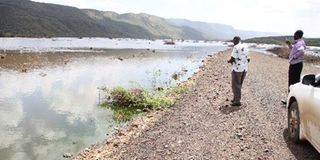Tourism hit as heavy rains destroy roads

Local tourists visit Lake Bogoria National Reserve in Baringo County on January 21, 2014. Flooding of the lake is a blow to tourism in the area as roads accessing the area have been destroyed and also caused geysers to submerge. JARED NYATAYA (Eldoret).
What you need to know:
- Major tourist hotels in the area, which usually offer accommodation facilities, are also feeling the pinch of the low tourist turnout, with most of them depending on conferences and meetings to remain afloat.
The tourism sector in Baringo County is facing a major setback after heavy rains last year rendered roads leading to major parks impassable.
The worst hit is Lake Bogoria Game Reserve, where the management in conjunction with the county government has been forced to create alternative routes after the lake burst its banks, destroying many roads.
A check by Smart Company recently found many tourists struggling to access the reserve, which was recently listed as one of the world heritage sites.
The situation has been aggravated by migration of millions of flamingos, which are a major tourist attraction at the lake. The birds have migrated to Lake Natron in northern Tanzania for breeding.
The birds’ population at the lake now stands at a mere 2,000, compared with more than 1.2 million flamingos in July last year.
Park game warden James Kimaru acknowledged that flooding has significantly affected the reserve, adding that new roads to the site are being created.
“Tourists should not fear touring Baringo County, which has some of the best sites in the world. Besides the hotsprings and flamingos, there are other hidden treasures like caves, not to mention attractive scenery,” Mr Kimaru said.
He said the breeding season for flamingos is between February and April every year when they usually migrate to Lake Natron and return in May.
“Food shortage for the birds has aggravated the situation. The lake is alkaline, which usually makes it easy for the birds to feed on algae. However, this has not been the case this year as the alkalinity of the lake has gone down due to a lot of water occasioned by heavy rains late last year,” Mr Kimaru said.
The downpour led to many of the hot springs, a key tourist attraction, being submerged. The only remaining geyser is at Mawe Moto, at Loboi Gate area, more than 18km inside the reserve.
Statistics indicate that more than 100,743 tourists visited the reserve in 2012, compared with 91,275 in 2013.
Mr Kimaru said last year’s target was between 120,000 and 150,000 tourists but the floods hampered their efforts.
“However, we are hopeful of reaching our target this year following the new status of the reserve as a world heritage site, which has boosted its marketing status in the world,” Mr Kimaru told Smart Company.
Major tourist hotels in the area, which usually offer accommodation facilities, are also feeling the pinch of the low tourist turnout, with most of them depending on conferences and meetings to remain afloat.
Lake Bogoria Spa Resort manager Lydia Dentewo acknowledged that flooding in many Rift Valley lakes has adversely affected tourism, with some visitors cancelling their bookings. Other lakes affected include Nakuru and Naivasha.
“We are liaising with the county government to enhance the opening of the road network at the reserve so that we don’t lose our clientele. We have set up more than 120 rooms and tented camps to cope with the high number of customers seeking accommodation after other hotels were submerged by floods,”Ms Dentewo said.
Some of the major hotels whose activities have been hampered by the heavy downpour include Block Hotels and Roberts Camp. Also affected is Lake Baringo Reptile Park, which has been completely submerged.
Ms Sarah Tomno, general manager of Rift Valley Adventures, Tours and Hotels, which runs Soi Safari Lodge located on the shores of Lake Baringo, said they were not been affected after Lake Baringo burst its banks.
“Heavy rains have not affected us as we are situated on a higher ground.”




